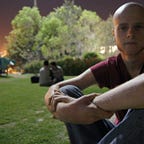How Does the Most Effective Treatment for Anxiety Work?
The psychoanalyst listened as his patient described her sexual adventures. She struggled with anxiety. “The sexual desires of her id are unacceptable to her super-ego,” he thought.
He had undergone extensive training. All he had to do was to listen. As her subconscious desires flowed to the surface of her consciousness, she would feel better.
“How are you feeling?” he asked.
“Anxious,” she replied.
“But you feel better, right?”
“No. I feel worse.”
He was puzzled. This was a tough one. He thought for a moment, then did something unheard of at the time. He asked her why. His collegues would have laughed in his face. Patients couldn’t possibly know why they were anxious. Anxiety, they preached, was a manifestation of conflicts hidden away deep inside them. It took a trained psychoanalyst™ to uncover these conflicts.
“I’m afraid that I’m boring you. I’m always afraid of boring people. That’s why I’m anxious.”
He then quizzed her about these thoughts, and realized that her anxiety came from her strange interpretations. If a friend hadn’t called her, she interpreted this as a sign that no one liked her. If he didn’t react with enthusiasm to her stories, she interpreted this as a sign that he thought she was boring.
He asked her whether she thought her interpretations made sense. She thought about for a minute, then said: “No.” He asked her to make alternative interpretations that were more rational. She did. And then something strange happened.
She felt better.
The psychoanalyst was amazed. He tried the same technique on other patients, and it worked. Excited, he gave a talk to the other psychoanalysts. He was sure they would be just as enthusiastic as himself.
They weren’t. In fact, they were pissed. So pissed, that they said he was no longer a psychoanalyst.
If not a psychoanalyst, who was he?
He was Aaron Beck, one of the founders of Cognitive-Behavioral Therapy (CBT). CBT is now the most effective treatment of anxiety in the world. How does it work?
EXPOSURE THERAPY
Our brains are hard-wired to detect threats. But to keep you safe, it needs to detect signs of danger before the danger is actually present. You should be able to interpret the flight of the birds as a sign that scary animals may be approaching before they’re there. Licking their lips.
In anxiety, signs of danger are detected … without there actually being danger. A laugh becomes a sign of rejection. A rash becomes a sign of fatal illness. A phone call becomes a sign of impending doom.
In CBT, exposure is about exposing the patient to their personal signs of danger. This is done to show them that there is nothing to be afraid of.
Often, sufferers of anxiety will engage if what is known as safety behavior and avoidance. These are responses to anxiety that are comforting. For instance, a person with panic disorder may avoid crowded places, fearing that they will have a panic attack. During therapy, they will be exposed to crowded places in order to show them that this doesn’t bring on panic attacks. Sufferers of obsessive-compulsive disorder may believe they have to perform a specific ritual to avoid a catastrophy. During therapy, this safety behavior will be interrupted.
COGNITIVE THERAPY
Our brains are also hard-wired to spot cause-and-effect relationships. When something important happens, associations pop into our heads. These associations are built by our patterns of thinking. They are shortcuts. Automatic answers to what caused a certain effect.
While this shortcut system is often very helpful, in anxiety it can be excruciating. We get obsessed with a certain effect (danger), and our anxiety is reinforced by our automatic thoughts. These automatic thoughts, if left unchecked, turn into beliefs. And from there it’s a slippery-slope to depression.
Cognitive therapy is about examining these automatic thoughts. It’s about finding more rational explanations for what’s going on.
CONCLUDING REMARKS
Cognitive-behavioral therapy is a great treatment for post-traumatic stress disorder (PTSD), generalized anxiety disorder (GAD), obsessive-compulsive disorder (OCD), panic disorder (PD), specific phobias, and social anxiety disorder.
It works by replacing maladaptive interpretations of signs of danger with more sensible interpretations, and automatic thoughts with rational thoughts.
It is important to remember that anxiety does not mean you’re defective. That would be a faulty interpretation. Anxiety means your brain is working hard at keeping you alive. It’s just erring on the safe side. It helped your ancestors. Otherwise you wouldn’t be reading this.
Anxiety is caused by automatic processes. But you can reflect on these processes, and stop them before they take you somewhere you don’t want to be.
If you can catch just one sign that these thoughts aren’t really making sense, you are making great progress. And that sign would not be a false one.
You may also be interested in this story: Anxiety Shuts Down the Decision Center of Your Brain
